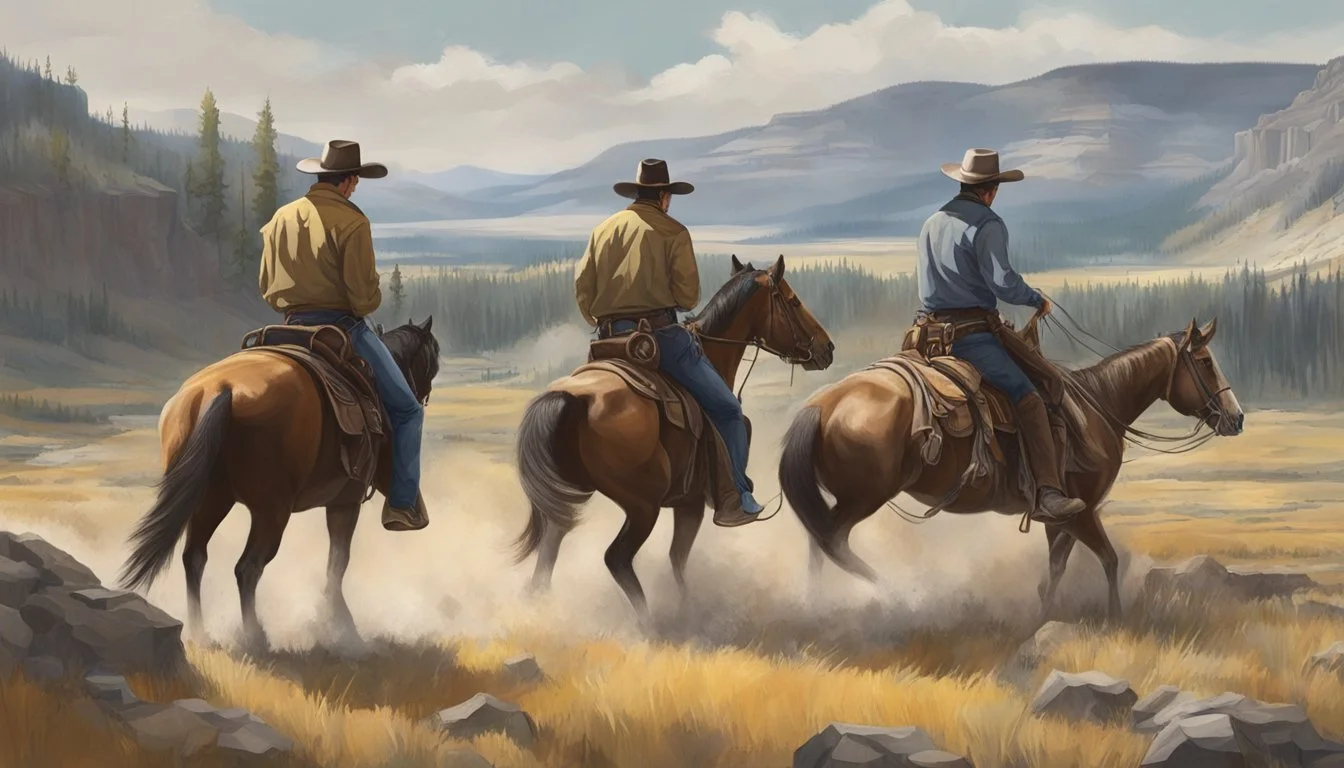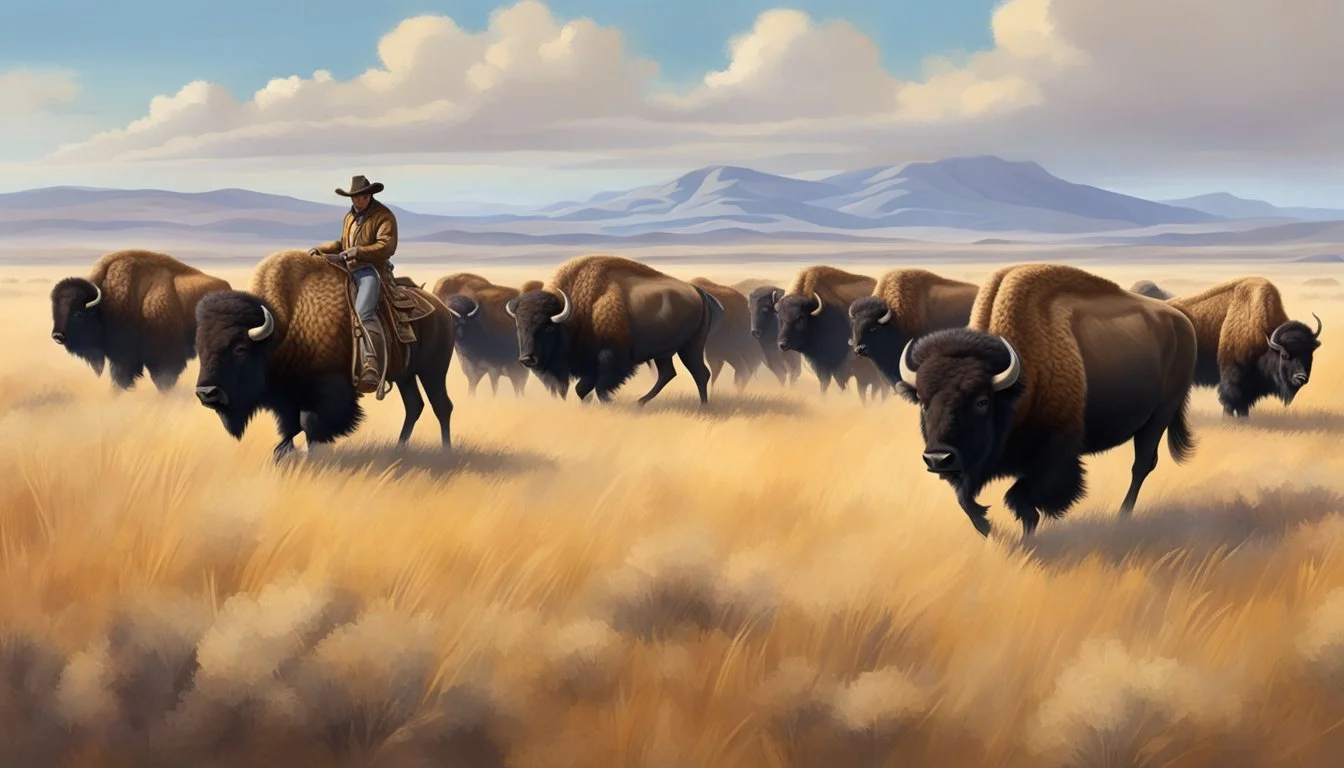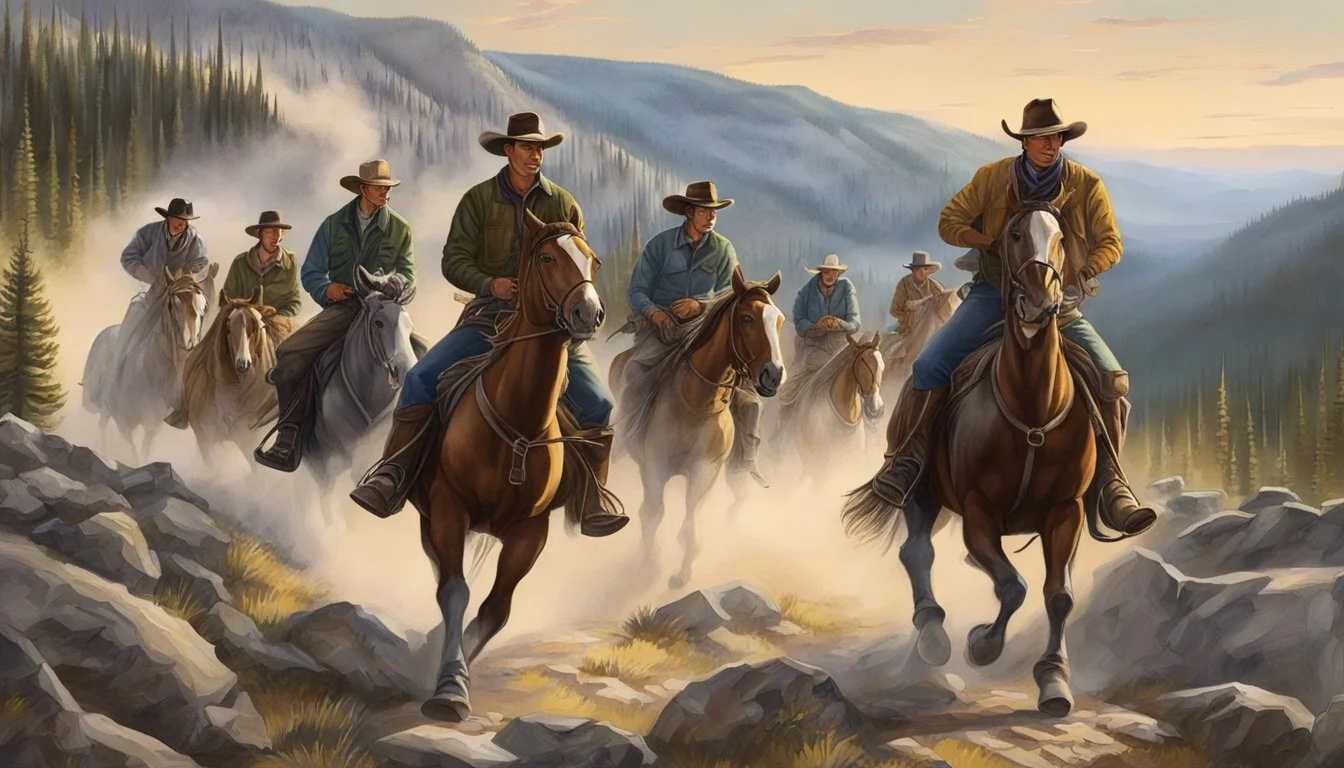Yellowstone Exposes Shocking Truths Behind 21st Century Land Wars
Yellowstone National Park, established in 1872, has long been a symbol of America's natural heritage. Today, it serves as the backdrop for a modern exploration of land disputes in the 21st century through the popular TV series "Yellowstone."
The show portrays complex conflicts between ranchers, Native Americans, land developers, and government entities, mirroring real-world tensions over land use in the American West. These fictional struggles resonate with viewers, highlighting the ongoing challenges of balancing conservation, economic development, and cultural preservation in the region.
"Yellowstone" brings these contemporary issues to the forefront, sparking discussions about property rights, environmental stewardship, and the changing face of the West. By framing age-old conflicts in a modern context, the series offers a unique lens through which to examine the evolution of land politics since the park's founding over 150 years ago.
Historical Context of Land Disputes
Land disputes in the American West have deep historical roots stretching back to the frontier era. These conflicts have shaped the region's development and continue to influence modern debates over land use and ownership.
From the American Frontier to Modern Conflicts
The American frontier was characterized by westward expansion and the notion of Manifest Destiny. This ideology drove settlers to claim new territories, often at the expense of Native American populations.
As the frontier closed in the late 19th century, land disputes shifted to focus on resource control and property rights. Conflicts arose between ranchers, farmers, and industrial interests.
The Homestead Act of 1862 encouraged settlement by offering 160 acres of public land to citizens who improved it. This policy had long-lasting effects on land ownership patterns in the West.
Key Historical Events Influencing Land Ownership
The 1838 exploration of the Yellowstone area marked the beginning of increased government interest in the region's natural resources. This eventually led to the establishment of Yellowstone National Park in 1872.
World War I and World War II had significant impacts on land use in the West. The wars created demand for resources and led to increased federal control over public lands.
The Taylor Grazing Act of 1934 regulated public land use for livestock grazing, introducing new tensions between ranchers and the government. This act remains influential in modern land management practices.
The Transformation Post-Great Depression
The Great Depression drastically altered the economic landscape of the American West. Many small farmers and ranchers lost their land, leading to consolidation of properties.
New Deal programs like the Civilian Conservation Corps focused on land conservation and development of public spaces. These efforts reshaped the relationship between communities and public lands.
Post-Depression, there was a shift towards more federal involvement in land management. This trend continued through the 20th century, creating ongoing debates about local autonomy versus national interests.
The rise of environmental consciousness in the mid-20th century added new dimensions to land use debates. Conservation efforts began to compete with traditional resource extraction and development priorities.
Yellowstone: Preserving the Wilderness
Yellowstone National Park stands as a testament to conservation efforts in the United States. Its vast landscapes and diverse ecosystems require ongoing protection to maintain their natural beauty and ecological balance.
Conservation Milestones and Challenges
Yellowstone became the world's first national park in 1872, setting a precedent for wilderness preservation. This designation marked a significant shift in land management policies.
Over the years, the park has faced numerous conservation challenges. These include:
Balancing visitor access with ecosystem protection
Managing wildfires and their ecological impacts
Mitigating the effects of climate change on park ecosystems
Park managers have implemented various strategies to address these issues. They've adopted sustainable tourism practices and invested in scientific research to guide conservation decisions.
Wildlife Conservation and Management
Yellowstone is home to diverse wildlife, including iconic species like grizzly bears, wolves, and bison. Protecting these animals is a core part of the park's mission.
Key wildlife conservation efforts include:
Reintroduction of wolf populations in the 1990s
Bison management to prevent disease transmission to livestock
Grizzly bear population monitoring and habitat protection
These initiatives have led to notable successes, such as the recovery of wolf populations and the stabilization of grizzly bear numbers. However, challenges remain in managing human-wildlife conflicts and preserving critical habitats.
Greater Yellowstone Ecosystem
The Greater Yellowstone Ecosystem extends beyond park boundaries, encompassing surrounding public and private lands. This vast area is crucial for maintaining the ecological integrity of Yellowstone itself.
Conservation efforts in this region focus on:
Protecting wildlife migration corridors
Preserving watershed health
Managing land use to minimize habitat fragmentation
Collaboration between federal agencies, state governments, and private landowners is essential for effective ecosystem management. Conservation organizations also play a vital role in supporting research and advocating for protective measures.
The preservation of the Greater Yellowstone Ecosystem faces ongoing challenges from development pressures and competing land use interests. Balancing these demands with conservation goals remains a complex and evolving task.
Cultural and Economic Landscape
The American West's cultural and economic landscape is evolving rapidly, shaped by the interplay of tradition, modernization, and diverse interests. Ranching, tourism, urban development, and Native American rights all contribute to a complex tapestry of change in regions like Yellowstone.
Ranching: A Symbol of the American West
Ranching remains a powerful symbol of the American frontier and cowboy culture. In Montana, vast cattle ranches still dominate the landscape, preserving a way of life deeply rooted in the American psyche. These ranches face mounting pressures from land developers and changing economic realities. Many struggle to remain profitable in the face of rising costs and environmental regulations.
Ranchers adapt by diversifying their operations. Some open their properties for tourism, offering authentic Western experiences. Others embrace sustainable practices to appeal to eco-conscious consumers. Despite challenges, ranching continues to shape Montana's identity and economy.
Tourism and Urban Expansion Impacts
Tourism has become a major economic driver in the Yellowstone region. Millions visit annually, drawn by the park's natural wonders and the allure of the American West. This influx brings significant revenue but also strains local resources and infrastructure.
Bozeman exemplifies the rapid urban expansion occurring near Yellowstone. The city's population has grown substantially, attracting new residents seeking proximity to outdoor recreation. This growth spurs economic development but also raises concerns about:
Housing affordability
Loss of open spaces
Increased traffic and pollution
The balance between preserving the area's natural beauty and accommodating growth remains a contentious issue.
Native American Rights and Tribal Sovereignty
Native American tribes play a crucial role in the cultural and economic landscape of the Yellowstone region. Tribal nations assert their sovereignty and work to protect their ancestral lands and cultural heritage.
Key issues include:
Land use rights within and around Yellowstone
Management of natural resources
Preservation of sacred sites
Tribes engage in economic development initiatives, including casinos and tourism ventures, to support their communities. They also partner with conservation efforts, bringing traditional ecological knowledge to land management practices.
Tensions persist between tribal interests and federal and state governments. Ongoing negotiations aim to address historical injustices and ensure Native American voices are heard in decisions affecting the region's future.
The Dutton Family Saga
The Dutton family's multi-generational struggle to maintain control of their vast Montana ranch forms the core of Yellowstone's narrative. Their saga intertwines family loyalty, economic pressures, and fierce battles over land rights.
Characters and Their Place in Yellowstone Lore
John Dutton stands as the patriarch, fiercely protective of the Yellowstone Ranch. His daughter Beth is a shrewd businesswoman, while son Kayce balances family obligations with his own path. Rip Wheeler, the loyal ranch foreman, becomes integral to the Duttons' operations.
Each character faces unique challenges that test their commitment to the family legacy. John grapples with modernization threats to his traditional way of life. Beth's ruthless tactics in the corporate world often clash with her personal relationships.
Kayce's military background influences his approach to ranch conflicts. Rip's unwavering dedication to the Duttons stems from his complex history with the family.
Family Loyalty Versus Economic Pressures
The Duttons constantly face economic pressures threatening their land. Developer interests, tribal claims, and government regulations all challenge their hold on the ranch.
John Dutton's refusal to sell often puts the family at odds with powerful entities. This stance sometimes strains relationships within the family, as members weigh personal ambitions against loyalty.
Beth's financial acumen becomes crucial in fending off corporate takeovers. The family employs both legal and questionable tactics to maintain their economic stronghold.
Agricultural challenges and changing market dynamics add another layer of complexity to the Duttons' struggle to keep their ranch viable.
Portrayal of Power Struggles and Land Rights
Yellowstone vividly depicts the complex power dynamics in modern Montana. The Dutton Ranch becomes a battleground for competing interests, including Native American tribes reclaiming ancestral lands.
Legal battles over water rights and property boundaries frequently escalate into physical confrontations. The series explores the grey areas of justice, where the Duttons' actions to protect their legacy often skirt ethical and legal boundaries.
Political maneuvering plays a significant role, with the family leveraging connections to maintain their influence. The show presents a nuanced view of how historical land ownership intersects with contemporary rights and regulations.
Media and Yellowstone's Popularity
Yellowstone has captivated audiences with its modern take on the Western genre, becoming a cultural phenomenon that extends beyond television. The show's popularity has sparked discussions about land disputes, family dynamics, and the changing American West.
Taylor Sheridan's Vision for a Contemporary Western
Taylor Sheridan, the creator of Yellowstone, reimagined the Western for the 21st century. He blended classic themes with contemporary issues, creating a narrative that resonates with modern viewers. Sheridan's approach focuses on complex characters and nuanced storylines that explore the tensions between tradition and progress.
The show's setting in Montana serves as a backdrop for examining land rights, conservation, and development conflicts. Sheridan's writing tackles these topics with authenticity, drawing from his own experiences and extensive research.
Kevin Costner's portrayal of John Dutton adds gravitas to the series, attracting viewers with his star power and compelling performance.
Evolving the Classic Western within Modern Culture
Yellowstone updates traditional Western tropes for a contemporary audience. The show explores themes of family loyalty, power struggles, and the clash between rural values and urban expansion.
By incorporating current social and political issues, Yellowstone bridges the gap between classic Westerns and modern dramas. This evolution has attracted a diverse viewership, from long-time Western fans to younger audiences seeking relevant storytelling.
The series' success has sparked a renewed interest in the Western genre, leading to the development of similar shows and spinoffs.
Influence on Pop Culture and Public Perception
Yellowstone's cultural impact extends far beyond television ratings. The show has influenced fashion trends, with fans emulating the characters' cowboy-inspired style.
Tourism in Montana has increased as viewers seek to experience the landscapes depicted in the series. This influx has both positive and negative effects on local communities.
Yellowstone's portrayal of ranching life and land disputes has sparked public discussions about conservation and property rights in the American West. The show's social media presence has created a community of engaged fans who debate these issues online.
Merchandise sales, including clothing lines and home decor, further demonstrate Yellowstone's reach into popular culture.
Wildlife and Land Stewardship
Private lands play a crucial role in wildlife conservation and habitat preservation around Yellowstone. Landowners face complex challenges in balancing economic needs with environmental stewardship. Innovative approaches are emerging to support large-scale conservation efforts across public and private boundaries.
Case Studies on Wildlife Conservation Issues
Grizzly bear management exemplifies the intricate balance between wildlife protection and human interests. As grizzly populations recover, conflicts with livestock and property damage have increased on private lands bordering Yellowstone. Some ranchers have adopted non-lethal deterrents like electric fencing and guard dogs to reduce encounters.
Elk migration presents another key issue. GPS collar studies reveal elk herds traveling up to 150 miles between summer and winter ranges. These routes often cross private ranchlands, creating both opportunities and challenges for landowners.
Habitat fragmentation due to development threatens species like pronghorn antelope. Conservation groups are working with willing landowners to maintain migration corridors through easements and land purchases.
Private Lands and the Role of the Landowner
Private landowners control over 30% of land in the Greater Yellowstone Ecosystem. Their decisions significantly impact wildlife habitat quality and connectivity. Many ranchers practice wildlife-friendly grazing techniques that benefit both livestock and native species.
Some landowners offer fee-based wildlife viewing or hunting access. This can provide economic incentives for habitat conservation. Others participate in government programs that offer financial support for implementing conservation practices.
Conservation easements have become an important tool. These legal agreements limit development while allowing continued agricultural use. Over 750,000 acres in the region are now under permanent easements.
Large-Landscape Conservation Initiatives
Collaborative efforts are key to preserving Yellowstone's wildlife across jurisdictional boundaries. The Yellowstone to Yukon Conservation Initiative aims to maintain habitat connections along a 2,000-mile corridor.
Public-private partnerships like the High Divide Collaborative bring together agencies, NGOs, and landowners. They focus on issues such as reducing wildlife-vehicle collisions and improving habitat resilience to climate change.
Land trusts play a vital role in these initiatives. Organizations like The Nature Conservancy and Trust for Public Land negotiate complex land deals to protect critical areas. Recent successes include securing winter range for bighorn sheep and preserving wetlands used by migratory birds.
Legal and Political Dimensions
Land disputes in Yellowstone involve complex legal frameworks, political maneuvering, and economic pressures. These factors shape the ongoing conflicts between conservation efforts and development interests.
Treaties and Legal Authorities Governing Land Use
The Yellowstone National Park Protection Act of 1872 established the legal foundation for the park's preservation. This landmark legislation set aside over 2 million acres for public use and enjoyment. Subsequent laws, such as the National Park Service Organic Act of 1916, further defined the park's management responsibilities.
Federal agencies like the National Park Service and U.S. Fish and Wildlife Service enforce regulations within park boundaries. State and local governments also play roles in managing surrounding areas. The Greater Yellowstone Ecosystem spans multiple jurisdictions, creating challenges for cohesive land management policies.
Treaties with Native American tribes add another layer of complexity. Historical agreements often impact current land use decisions and resource management practices.
Political Maneuvering and Power Dynamics
Political interests heavily influence Yellowstone's land disputes. Local, state, and federal officials often have conflicting agendas regarding park management and development.
Lobbying efforts by various stakeholders shape policy decisions. Conservation groups advocate for stricter environmental protections, while business interests push for expanded access and development opportunities.
Election cycles can shift the balance of power, leading to changes in land use policies. Politicians may prioritize short-term economic gains over long-term conservation goals to secure votes and support.
Public opinion plays a crucial role in shaping political decisions. Media coverage and grassroots campaigns can sway public sentiment and influence policymakers' choices.
The Intersection of Economics and Land Preservation
Economic factors significantly impact land use decisions in and around Yellowstone. Tourism revenue provides a strong incentive for preservation, as the park's natural beauty attracts millions of visitors annually.
Property values in surrounding areas have skyrocketed, leading to increased development pressures. Wealthy individuals and corporations seek to acquire prime real estate, potentially threatening traditional ranching lifestyles.
Conservation easements offer financial incentives for private landowners to preserve open spaces. These agreements provide tax benefits while protecting critical wildlife habitats.
Sustainable tourism initiatives aim to balance economic growth with environmental protection. Local communities struggle to diversify their economies while maintaining the region's natural character.
The Future of Yellowstone and the American West
As Yellowstone approaches its 150th anniversary, the park and surrounding region face new challenges and opportunities. The evolving landscape requires balancing preservation with progress, while honoring the area's rich cultural heritage.
Opportunities for Cultural Preservation and Education
The modern cowboy culture depicted in "Yellowstone" highlights avenues for preserving Western heritage. Ranches like the fictional Dutton property serve as living museums, showcasing traditional practices and values.
Educational programs at Yellowstone National Park can expand to include more indigenous perspectives and cowboy culture. This approach would provide visitors with a fuller understanding of the region's history.
Technological advancements offer new ways to document and share the American West's stories. Virtual reality tours and interactive exhibits could bring the frontier experience to a global audience.
Challenges Ahead: Sustaining the Frontier Spirit
Climate change poses a significant threat to Yellowstone's ecosystems. Park managers must adapt conservation strategies to protect wildlife and natural resources.
Urban expansion and resource extraction continue to encroach on wilderness areas. Balancing economic development with land preservation will require innovative solutions and compromise.
The romanticized image of the American West conflicts with modern realities. Reconciling this idealized past with present-day challenges is crucial for authentic cultural representation.
The Role of Generations in Continuity and Change
Family legacies, like the Duttons', play a vital role in maintaining Western traditions. Passing down knowledge and values ensures the continuity of ranching and land stewardship practices.
Younger generations bring fresh perspectives to age-old issues. Their involvement in conservation efforts and sustainable ranching practices is essential for the region's future.
Bridging generational gaps can lead to innovative solutions. Combining traditional wisdom with modern technology and environmental science may create more resilient and sustainable land management practices.







